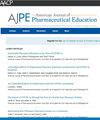A Narrative Review of Pharmacy Identity and the PharmD Experiment
IF 3.8
4区 教育学
Q1 EDUCATION, SCIENTIFIC DISCIPLINES
引用次数: 0
Abstract
Objectives
This narrative review summarizes the evolution of pharmacy education in response to the development of patient-focused pharmacy practice. It examines outcomes of the switch to Doctor of Pharmacy (PharmD)-only education, and discusses whether the needs of society and the profession are being met by that change.
Findings
The development of the PharmD degree paralleled the evolution of clinical pharmacy practice, with an emphasis on patients rather than products. Advocates of abandoning the Bachelor of Science in Pharmacy for the PharmD-only model predicted pharmacists would be able to devote full attention to serving patients’ pharmaceutical care needs. Preparing all pharmacists with a doctoral-level education was also anticipated to clarify their abilities and contributions in the minds of the public and other health care professionals. Skeptics warned of underutilization of pharmacist skills and stagnation of pharmacists involved in technical dispensing functions.
Summary
Nursing in the United States (US) and pharmacy in other countries offer models of tiered educational credentials and practice responsibilities that could clarify the connection between pharmacists’ education and responsibilities in the minds of the public. This tiering could be achieved through stepwise pharmacy degrees, or through intentional and consistent enhancement of the education and roles of pharmacy technicians. Several US states have already increased the responsibilities permitted to pharmacy technicians in support of a pharmacist supervisor.
药学认同与药学博士实验述评
目的总结药学教育的演变,以响应以患者为中心的药学实践的发展。它考察了转向药学博士(PharmD)教育的结果,并讨论了这种变化是否满足了社会和专业的需求。结果药学博士学位的发展与临床药学实践的发展是同步的,强调的是病人而不是产品。提倡放弃药学学士学位,转而采用纯药学模式的人预测,药剂师将能够全身心地关注为患者提供药学服务的需求。还期望所有药剂师都接受博士教育,以澄清他们在公众和其他保健专业人员心目中的能力和贡献。怀疑论者警告说,药剂师技能的利用不足,药剂师参与技术配药功能的停滞不前。美国的护理学和其他国家的药学提供了分层教育证书和实践责任的模式,可以澄清公众心目中药剂师的教育和责任之间的联系。这种分级可以通过逐步获得药学学位来实现,也可以通过有意和持续地加强药学技术人员的教育和作用来实现。美国几个州已经增加了药学技术人员的职责,以支持药剂师主管。
本文章由计算机程序翻译,如有差异,请以英文原文为准。
求助全文
约1分钟内获得全文
求助全文
来源期刊
CiteScore
4.30
自引率
15.20%
发文量
114
期刊介绍:
The Journal accepts unsolicited manuscripts that have not been published and are not under consideration for publication elsewhere. The Journal only considers material related to pharmaceutical education for publication. Authors must prepare manuscripts to conform to the Journal style (Author Instructions). All manuscripts are subject to peer review and approval by the editor prior to acceptance for publication. Reviewers are assigned by the editor with the advice of the editorial board as needed. Manuscripts are submitted and processed online (Submit a Manuscript) using Editorial Manager, an online manuscript tracking system that facilitates communication between the editorial office, editor, associate editors, reviewers, and authors.
After a manuscript is accepted, it is scheduled for publication in an upcoming issue of the Journal. All manuscripts are formatted and copyedited, and returned to the author for review and approval of the changes. Approximately 2 weeks prior to publication, the author receives an electronic proof of the article for final review and approval. Authors are not assessed page charges for publication.

 求助内容:
求助内容: 应助结果提醒方式:
应助结果提醒方式:


